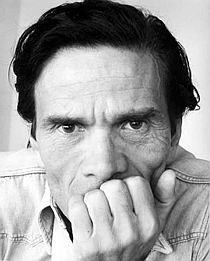


Pasolini in Rome in Berlin

On the way to the Zelig film school in Bolzano a stop was made in Berlin for some days. Apart from enjoying oysters in KaDeWee or la Fayette the city’s many good restaurants often have Kalbsleber in its classic version on the menu. And with Berlin with January weather you find it right to go to exhibitions. Three were visited, the RAF (Rote Armée Fraktion) in Deutsches Historisches Museum (until March 3), the West:Berlin in Ephrahim Palast and Pier Paolo Pasolini in Martin Gropius-Bau. As exhibitions the level of quality were in the same order.
The RAF was very interesting with lots of visuals (clips from the enormous amount of Dokumentation that has been made from the demonstrations, the fights in the streets, the story chronologically presented – but the elements had been given far too little space, it felt packed and klaustrophobic. So what do you do – you buy the catalogue! The approach of the exhibition organisers, a quote from the website can illustrate that: …In the 1970s the attacks took place primarily in southwest Germany. The Red Army Faction set their sights above all on the office of the Federal Prosecutor in Karlsruhe and the headquarters of the US Army in Heidelberg. The state reacted to the assassinations with the most extensive search and surveillance actions since the end of the Second World War. The escalation during the “German Autumn” of 1977 spread fear and a feeling of powerlessness among the people. Many citizens called for the death penalty for the terrorists… Sorry for not being more accurate but I could not see the exhibition for other visitors blocking the view!
West:Berlin with the subtitle ”an Island in Search of the Mainland” in three floors at Ephraim Palast with the beautiful staircase was a detailed presentation of daily life, culture, politics, ”die Mauer” of course, ”die Luftbrücke”, the division of territories between the four big ”allied powers” etc. The phonetics of Kennedy’s famous ”Ich bin ein Berliner” = ”bearleener”. On the third floor I sat down and listened to ”Berlin” by Lou Reed, ”Heroes” by David Bowie, ”Bahnhof Zoo” by Nina Hagen – all three tracks connected to the time and the city. An official exhibition by the Stadtmuseum that was well made, informative and with entertaining elements. In ”Berliner Zeitung” the reviewer, born and raised in the East, acknowledged the exhibition and called for an equivalent seen from the East Berlin pov!
And then 3 hours with Pier Paolo Pasolini (1922-75) (PPP) in Martin Gropius-Bau, the last day of the amazing exhibition that takes the viewer from 1950, when PPP arrived in Rome till 1975 and his tragic death. Film by film, scandal by scandal, his homosexuality, his love stories and first and foremost his artistic development as a writer, screenwriter, film director, visual artist, philosopher, political commentator… What a creative force! For me who saw ”Accatone” and ”Mama Roma” as a teenage film freak in art cinemas in Copenhagen back in the 1960’es, it was a joyful visit to film history making you want to run for the best possible dvd box of the director’s films from these two to ”Salo” from 1976. There were his hand-written scripts, there was a fabulous audio-clip where Pasolini discusses a scene from ”Mama Roma” with Anna Magnani – well, there are several interviews with PPP and even a clip from a football match between the film crew of Bertolucci’s ”1900” and Pasolini’s ”Mama Roma” (or was it another film?). ”1900” won 5-2 and the actress Laura Betti, always close to PPP, proudly carries the trophy. One film I have never seen, ”Ricotta” (part of Ro.Go.Pag), with Orson Welles, a film that sentenced PPP to prison for blasphemy. The exhibition includes clips from the film and one with the judge, who decided to sentence the director. Great exhibition, have no idea where it goes from Berlin, as it has been at the three locations/organisations that have created it: Cinemathèque Francaise, Palazzo delle Esposizione in Rome, the CCCB in Barcelona and Martin Gropius-Bau, Berlin. Wheredoes an exhibition like this with all its brilliant elements end up, when it has taken its (first hopefully) tour to Paris, Barcelona, Rome and Berlin? Thanks to the curators Alain Bergala, Jordi Balló and Gianni Borgna for their work! There is a fine 10 minutes video intro on the website of the CCCB, see below.
https://www.dhm.de/ausstellungen/raf.html
http://www.cccb.org/en/exposicio-pasolini_roma-43159